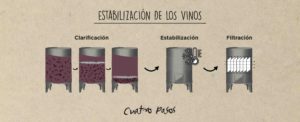Wine stabilization
Once the wine has been produced, there are three key processes to end it: clarification, stabilization and filtration.
These last three techniques aim to avoid the presence of sediments in the wine when it gets to the consumer.
That is what we are discussing in today’s post.
Clarification is used to remove proteins and matter in suspension. To do so, a clarifier will be chosen (bentonite, pvpp and isinglass are the most common for white wine whereas albumin or egg whites and gelatine are used for red wine) and mixed with the wine. They let it settle for a while, so it can act dragging the wine solids in suspension, which are gathered in the bottom of the tank.
After the clarification comes the cold stabilization process if necessary, since for some red wines it is not necessary because they are stable regarding the tartaric acid fall. To do that, the wine is cooled so the tartaric acid salts which are not soluble at less temperature can fall in the tank. This is done once the wine is clean enough after having done the clarification technique.
Finally, we move on to filtration which is a technique that will totally remove the unstable tartaric acids, clarification rests and the matter in suspension, passing the wine through a filtering layer with very thin pores. The most common way to do it is using soil, plate or tangential filters.



